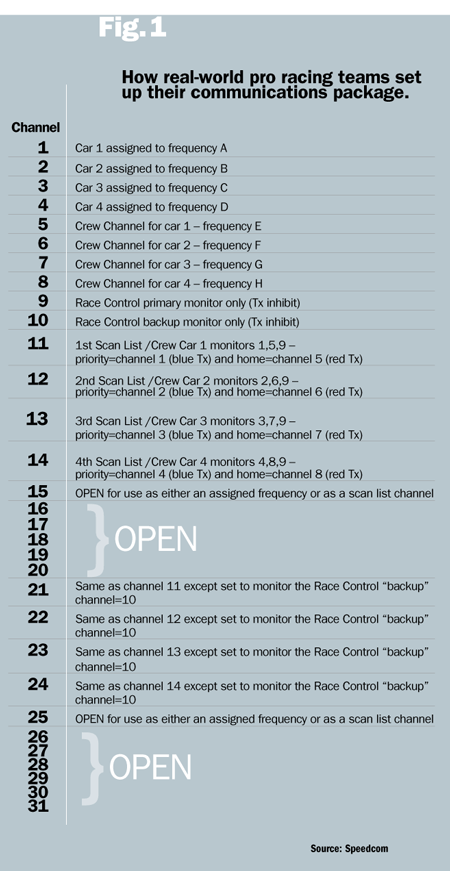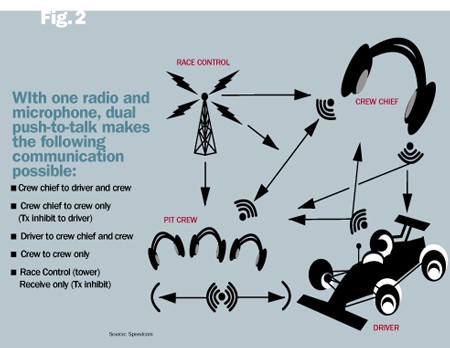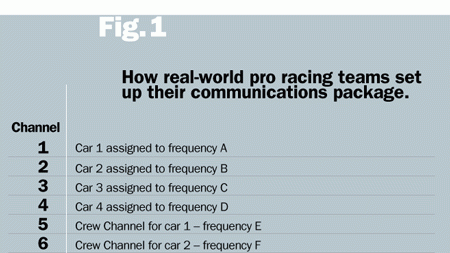Switching channels while switching gears
Several fundamental shortcomings have limited the effectiveness of conventional radios for decades. For instance, users may initiate conversations only on one channel (or talk group) when operating on a scan channel (or job list). Should a user find it necessary to initiate conversation with a second talk group (or channel), then the user must manually switch channels, or wait for a second talk group to initiate a conversation. This makes operation more difficult and, in some circumstances, highly impractical. In addition, by switching channels — or exiting the current scan list — to initiate conversation with a second talk group, the user will not hear any conversation from the first talk group.
However, these challenges can be overcome by employing multiple push-to-talk (P2T) switches, coupled with proprietary internal circuitry, which enables a single radio to conveniently manage multiple talk groups without the need to manually switch channels.
DualTalk technology — a feature of Speedcom’s DT100 radio — employs two separate remotely mounted P2T buttons, each of which activates a single and commonly shared microphone and creates a different path through the radio’s internal circuitry. DualTalk primarily was designed to be deployed in radio headsets, with one button mounted on each of the two ear cups. However, the technology also will work with a single shoulder mounted microphone/speaker — such as those commonly used by police and security personnel — or with a lapel microphone, as long as they are equipped with dual P2T buttons.
Because DualTalk-enabled radios employ multiple scan (or job) lists, the user is able to address different talk groups for specific job applications in a larger variety of configurations. Easily accessing separate scan lists gives a huge advantage to end users who employ two-way portable radios in some professional capacity.
Scan and job lists, as well as talk groups and channels, can be easily and quickly programmed and re-programmed by authorized dealers or service personnel using optional software. Users whose scan lists change frequently will want to obtain their own programming software.
Given that dual P2T technology was born in the environment of professional motor sports, it would be useful to examine how a racing team would use such a system. While conventional radios offer scan list capability, they max out at about six lists. However, a dual P2T radio can accommodate three times that amount because of its 31-channel capability. This becomes very important in the modern world of multiple-car teams. Figure 1 details the typical channel assignments for a four-car race team.

Crew personnel working on car number 2, for example, only need to remember channels 12 and 22. And if the crew person is re-assigned to car number 4 during the race, a simple manual swap to channel 14 puts the crewman in touch with what’s going on in the pits for car 4. Channel 24 then serves as the backup. For non-racing professionals this means users don’t have to reprogram their radios during the work day — or even before work — because dual P2T radios provide the versatility to create multiple job list scenarios and the volume to keep them accessible for speedy crossovers.
A key difference between dual P2T and other systems becomes apparent upon careful scrutiny of Figure 1. In addition to possessing a greater number of channels, dual P2T radios are much more versatile than conventional radios because each channel can become a scan or job list. By incorporating a dual P2T function, the user more easily switches between talk groups, which is a tremendous advantage when the job requires focus and quick response, as it does in auto racing. Figure 2 illustrates how a racing team would use a dual P2T system.

A racing team typically has the following two-way radio needs or talk-group subdivisions:
-
team owner
-
team manager
-
crew chief
-
driver (in car, boat or on motorcycle)
-
spotters (advising driver from strategic vantage points)
-
team engineer
-
pit crew members
-
support personnel
For safety reasons, the driver must hear only the transmissions relating specifically to on-track conditions. All other communications — such as tire-pressure reports from the pit crew and discussions of pit equipment problems — need to be kept out of the driver’s ears. All of this behind-the-scenes squawk will not only detract seriously from the driver’s focus, it could actually be fatally misleading. The driver needs filtered, thought-out and final instructions; the information only a crew chief should give. Therefore, the team may elect that only the crew chief and spotters transmit to the driver, but all team personnel can receive the driver’s transmissions.
While a conventional radio system can accomplish that, a dual P2T system — which provides the crew chief with one two-way unit and one microphone — enables him to also speak separately to everyone else on the team without the driver receiving the transmission and without the need to manually switch channels. Or, the crew chief’s unit could designate one button for transmissions to the driver and crew, with the other button designated for transmissions to the crew only.
Myriad configurations are possible. For example, the team owner or manager’s radio could be programmed so that one button would be used to transmit to the crew chief only, while the other button transmits to the driver and the crew chief. Or, each crewman’s radio could be programmed to send to the crew chief using one button, while the entire pit crew (including team engineer and crew chief) uses the other button. Similarly, the team engineer’s two-way could be set up so that one button is used to transmit exclusively to the crew chief and the team owner or manager, while the other button sends to everyone except the driver.
In the days leading up to a race, team communications are fairly relaxed. Consequently, team management could elect to open two-way radio communications to the entire team (with the exception of the driver during race qualifying). For practice days this might be helpful. Then, on the morning of the race, all radios could be quickly reprogrammed for their specific talk-group with just a patch-up to the communication engineer’s laptop. They also can be individually reprogrammed manually at the radio, if necessary.
An ancillary benefit of the dual P2T technology is the ability to reprogram frequencies and PL tones on the fly. This capability could make it possible, for example, for one race team to eavesdrop on what another team is saying. The result might give the eavesdropping team better information to re-work their race strategy — and it’s perfectly legal in the auto-racing world.
Toto Lassally is CEO of Deland, Fla.-based Speedcom Communications. Early in his career Lassally developed a deep interest in 12 V car stereo technology and won several national competitions. Later, he became fascinated with auto racing and eventually formed his own racing team, Marcos Racing USA, to compete in the 24 Hours of Daytona and Grand American race series for sports cars. The desire to improve race car-to-team communications led to the development of the DualTalk dual P2T technology.

















